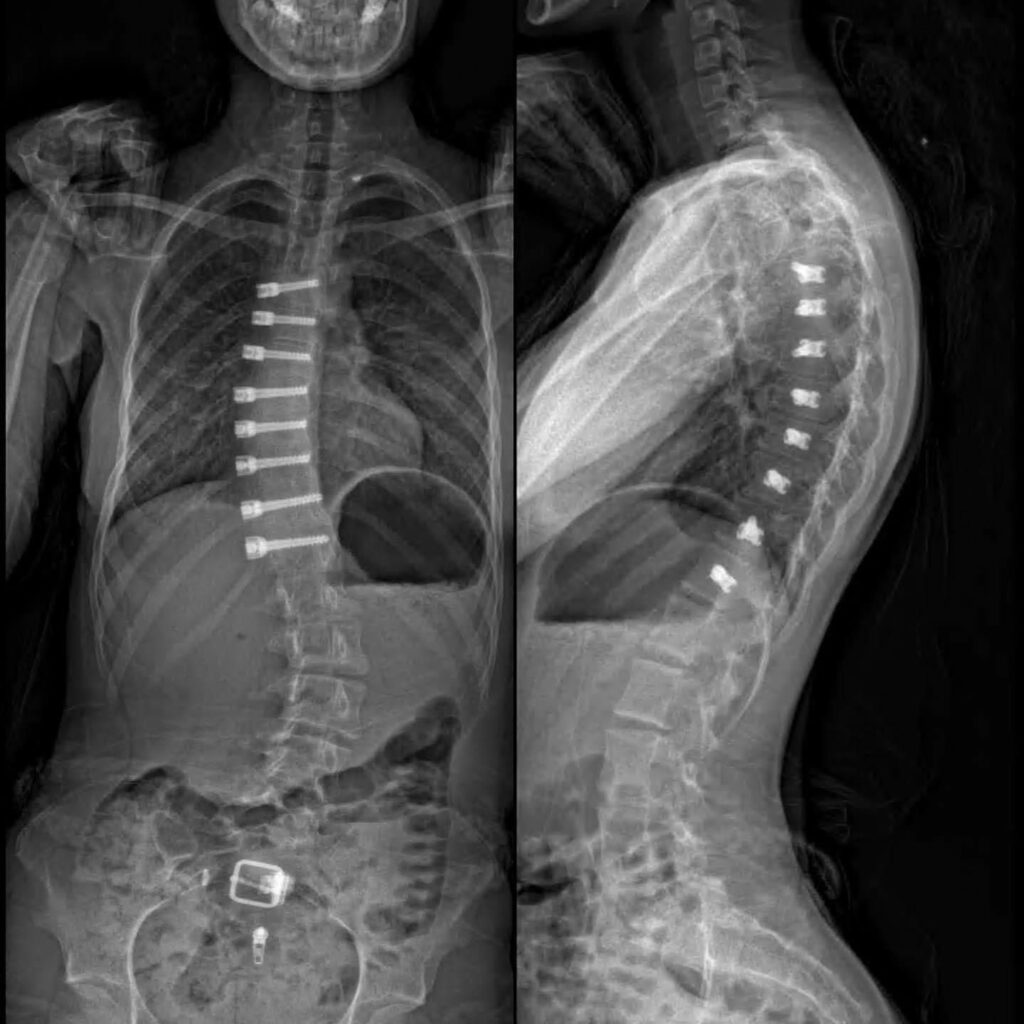Vertebral Body Tethering
Dr. Asghar is one of the first surgeons in Florida to offer the new FDA approved Vertebral Body Tethering System.

The Tether – Vertebral Body Tethering System is different than typical scoliosis surgery, called a “spinal fusion,” which involves implanting stiff metal rods along either side of your spine to straighten the undesirable curves.
Rather than stiff metal rods, The Tether System uses a strong, flexible cord to pull on the outside of a scoliosis curve to straighten the spine. The system permanently straightens your spine using your own growth process.
This process is called “growth modulation.” The bones, or “vertebra,” in a scoliotic spine are wedge-shaped, tall on one side and short on the other. When the vertebrae are pulled by the cord, it puts pressure on the tall side of the vertebrae on the outside of the curve.
This pressure slows the growth on the tall side of the vertebrae so that the short side can grow and catch up. After surgery, the spine may continue to straighten over time as you grow.
The Tether System is different from the other surgical treatments for scoliosis — e.g. spinal fusion — because the spine is still able to bend and flex, rather than being fixed in place with the stiff metal rods needed for spinal fusion. However, when it comes to The Tether, it is important to be seek treatment while you are still growing, so the implants can allow the spine to correct itself over time.
The Tether System is considered a special category of medical devices that are called Humanitarian Use Devices (HUD). This means that The Tether System is specially approved for idiopathic scoliosis in young people who have scoliosis with a significant amount of growth remaining. Due to this being a rare condition The Tether System has not been proven to help all cases of scoliosis.
Instead, The Tether System has been shown to have a probable benefit. The Tether is the only medical device available that treats scoliosis while a person is actively growing and uses his or her own growth to repair the curve.
Rather than stiff metal rods, The Tether System uses a strong, flexible cord to pull on the outside of a scoliosis curve to straighten out the spine. The system permanently straightens your spine using your own growth process. This process is called “growth modulation.” The bones, or “vertebra” in a scoliotic spine are wedge shaped, tall on one side and short on the other. When the vertebrae are pulled by the cord, it puts pressure on the tall side of the vertebrae on the outside of the curve.
This pressure slows the growth on the tall side of the vertebrae, so that the short side can grow and catch up. After surgery, the spine may continue to straighten even more over time as you grow.
The Tether System is different from the other surgical treatments for scoliosis — e.g. spinal fusion — because the spine is still able to bend and flex, rather than being fixed in place with the stiff metal rods needed for spinal fusion. However, when it comes to The Tether, it is important to be treated while you are still growing, so that the implants can allow the spine to correct itself over time.
The Tether System is a special category of medical device called a Humanitarian Use Device (HUD). This means that the device is specially approved for idiopathic scoliosis in young people who have scoliosis with a significant amount of growth remaining because this is a rare condition and The Tether has not been proven to help all cases of scoliosis.
Instead, The Tether System has been shown to have a probable benefit. The Tether is the only medical device available that treats scoliosis while a person is actively growing and uses his or her own growth to repair the curve.
Rather than stiff metal rods, The Tether System uses a strong, flexible cord to pull on the outside of a scoliosis curve to straighten out the spine. The system permanently straightens your spine using your own growth process. This process is called “growth modulation.” The bones, or “vertebra” in a scoliotic spine are wedge shaped, tall on one side and short on the other. When the vertebrae are pulled by the cord, it puts pressure on the tall side of the vertebrae on the outside of the curve.
This pressure slows the growth on the tall side of the vertebrae, so that the short side can grow and catch up. After surgery, the spine may continue to straighten even more over time as you grow.
The Tether System is different from the other surgical treatments for scoliosis — e.g. spinal fusion — because the spine is still able to bend and flex, rather than being fixed in place with the stiff metal rods needed for spinal fusion. However, when it comes to The Tether, it is important to be treated while you are still growing, so that the implants can allow the spine to correct itself over time.
The Tether System is a special category of medical device called a Humanitarian Use Device (HUD). This means that the device is specially approved for idiopathic scoliosis in young people who have scoliosis with a significant amount of growth remaining because this is a rare condition and The Tether has not been proven to help all cases of scoliosis.
Instead, The Tether System has been shown to have a probable benefit. The Tether is the only medical device available that treats scoliosis while a person is actively growing and uses his or her own growth to repair the curve.

